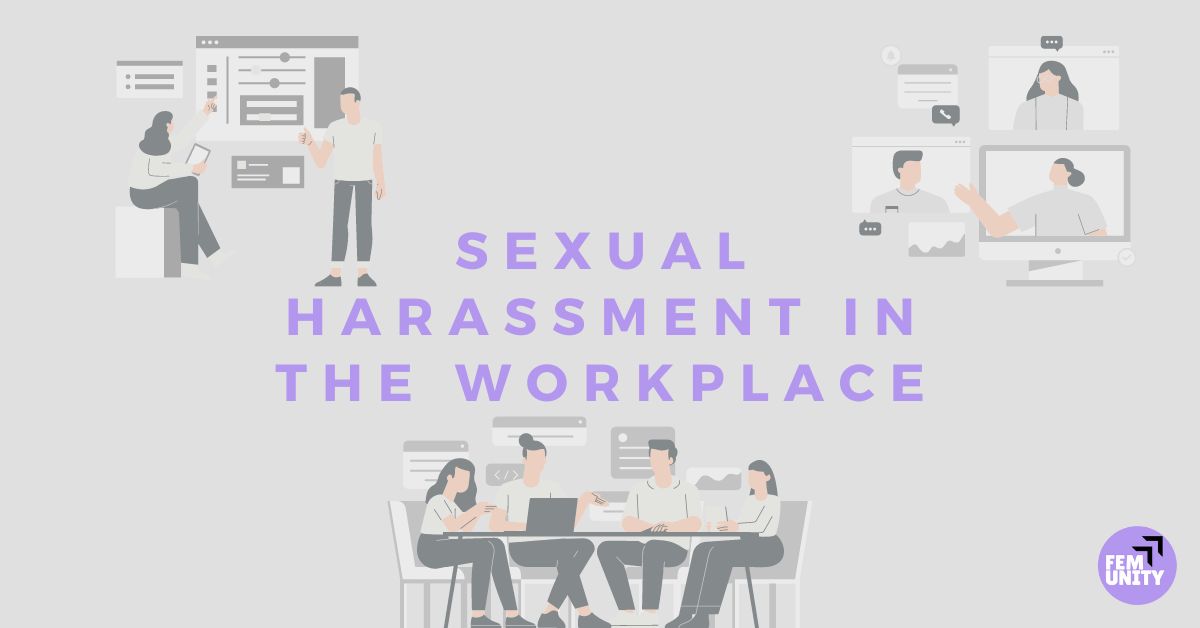Hey there,
I hope you are doing well and ready to read today’s topic, because it ain’t no fun topic, unfortunately. But a super important one!
Today I want to share with you some informative content on sexual harassment in the workplace.
One in three people have already experienced sexual harassment at work in the last five years.
How we can find a solution to it, is still unclear for many people. The majority doesn’t know that the employers are obliged to protect the employees from sexual harassment. And more than 70% also do not know who to talk to about this type of topic.
With a big difference, women are the ones being the victims. Two third of women have already been sexually harassed at work from a colleague or a boss. Sexual harassment means all kinds of action which are made out of the other’s consent.
Let’s define sexual harassment in the workplace:
It is a form of violence, which is primarily against women. It has different forms, for example through:
- sexual innuendos*, obscene words & gestures
- intrusive, unpleasant looks
- unwanted messages with sexual content
- unwanted showing & sending of pictures
- sexual touching
- threats of sexual violence
- violent acts
*when you say something which is polite and innocent on the surface, but indirectly hints at an insult or rude comment, a dirty joke, or even social or political criticism.
But not only women are targeted. Men also experience sexual harassment in the workplace. 7% of the men surveyed in a survey conducted by the Anti-Discrimination Agency said that they had been sexually harassed in the workplace. The harasser does not usually have to be attracted to the victim. In the work context, it is more a matter of demonstrating power, competition or expressing disrespect. Sexual harassment does not necessarily have to do with initiating contact, sex or the attractiveness of a person.
A study carried out in Switzerland in 2007 found that 28% of women and 10% of men who were questioned had experienced sexual harassment or similar behaviour in the workplace. The study showed that in ¾ of cases in which women were victims, the act was done by men (individuals or groups). And in around half of all cases of harassment victimising men, were perpetrated by men (individuals or groups).
It is your right to defend yourself!
Your employer has a legal duty to enable a work environment which is free of harassment for the employees. Your position in the company matters least. You did not provoke what happened in the first place, take it seriously and do not bottle it up.
Every person reacts differently to sexual harassment. Every incident is different.
There are no tips on how to behave that are always effective. Many victims do not take action against the events because they are afraid of misjudging the situation wrongly or to be put at a disadvantage by making a complaint. It can help to make it clear to the harasser that you feel harassed, both verbally and in writing by announcing consequences. But a direct and immediate reaction is not always possible.
To help you and guide you in which actions you can take, here are some examples:
Ask the perpetrator to STOP. Tell that person right away that their behaviour will not be tolerated and if not ceased, tell them you’ll file a complaint. If you cannot go upfront and talk with the harassor, try writing them a letter explaining what is upsetting you.
Another way is to get your colleagues involved. Raise your voice about it! Maybe you are not the only one experiencing harassment, that way you could join forces together.
When it comes to complaints, the sooner the sexual harassment is reported, the better. There are no time limits for complaints. However, they must be taken into account if the persons concerned want to claim damages or compensation.
It may then be useful to document each incident and contact trusted colleagues.
If you see someone else being harassed, here is what you can do;
- Don’t join in the laughter if someone makes a sexist joke or comment.
- Raise the issue of sexual harassment in the workplace
- Intervene directly during an incident
- Offer support when the harassed person seeks counselling
- Offer support if the harassed person defends him or herself
- Don’t do anything that the person concerned does not want you to do.
- Tell supervisors about the harassment.
- Agree to be a witness. You are protected against retaliatory dismissal.
If there is no complaints office in the company, there are outside agencies that offer help and support to those affected.
German readers:
Various help hotlines, trade unions, lawyers and counselling centres are available here.
- Help hotline “Violence against women” Tel.: 0800/0116016
- Help & advice centre of the Federal Anti-Discrimination Agency Tel.: 030/185551865
- Weißer Ring .V. victim hotline (for victims of crime and violence), Tel.: 116 006
Swiss readers:
The website www.sexuellebelaestigung.ch also contains addresses of conciliation boards, advice centres, experts, training courses for contacts, etc.
For more information, I would advise you to look further into these two documents – guides for the employees and employers, by following this link: https://www.ebg.admin.ch/ebg/en/home/topics/work/sexual-harassment-in-the-workplace.html
French readers:
39 19: Info telephone number “Violences Femmes”. This is a national number for women who are victims of violence, as well as for those around them and the professionals concerned. This national helpline is anonymous. It is accessible and free of charge from a landline or mobile phone in mainland France and the overseas departments. The number is open from Monday to Friday from 9am to 10pm, Saturdays, Sundays and public holidays from 9am to 6pm.
Specialised associations:
- The European Association against Violence against Women at Work (AVFT): https://www.avft.org/
- National Centre for Information on the Rights of Women and Families (CNIDFF): https://fncidff.info/
Bibliography:
- Bureau RT1 de la sous-direction des relations individuelles et collectives du travail & Mission communication de la DGT. (2019, mars). HARCÈLEMENT SEXUEL ET AGISSEMENTS SEXISTES AU TRAVAIL : PRÉVENIR, AGIR, SANCTIONNER. https://travail-emploi.gouv.fr/IMG/pdf/30645_dicom_-_guide_contre_harce_lement_sexuel_val_v4_bd_ok-2.pdf
- Federal Office for Gender Equality FOGE & State Secretariat for Economic Affairs SECO. (2017, Januar). Sexual harassment in the workplace Information for employers (301.926.e). BBL, Vertrieb Bundespublikationen, CH-3003 Bern www.bundespublikationen.admin.ch



